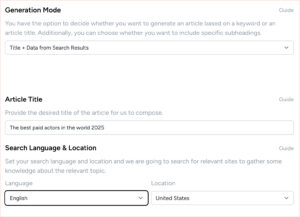In today’s digital age, we find ourselves inundated with an overwhelming amount of information every time we log in.
As businesses, we recognize the challenge this poses in capturing the attention of potential customers. This is where content personalization steps in as a game-changer. By tailoring our messages and offerings to meet the unique needs and preferences of each individual, we not only enhance user experience but also significantly boost our chances of customer acquisition.
We’ve all experienced the frustration of irrelevant ads or generic content that doesn’t resonate with us. Conversely, when we encounter content that feels curated just for us, it creates a sense of connection and relevance that can compel us to engage.
In this article, we will delve into the pivotal role content personalization plays in attracting and retaining customers, and explore strategies we can implement to ensure our content consistently hits the mark.
Key Points:
-
Enhancing User Experience:
- Tailoring messages and offerings.
- Meeting unique needs and preferences.
-
Boosting Customer Acquisition:
- Increasing relevance.
- Creating a sense of connection.
Strategies for Effective Content Personalization:
-
Data Collection:
- Gather data on user behavior and preferences.
- Use analytics to understand customer journeys.
-
Segmentation:
- Create customer segments based on similar traits.
- Personalize content for each segment.
-
Dynamic Content:
- Implement dynamic content that changes based on user interaction.
- Use AI and machine learning to predict and deliver personalized content.
By focusing on these strategies, businesses can ensure their content consistently resonates with their audience, leading to higher engagement and customer loyalty.
Importance of Personalized Content
Personalized content is crucial because it directly addresses the unique needs and preferences of each customer, enhancing engagement and conversion rates.
When we create content that speaks to individual experiences, we make our audience feel valued and understood. This sense of connection fosters a community where customers feel they belong, driving deeper engagement and loyalty.
Using data analytics, we can gather insights into our customers’ behaviors and preferences. With this information, we tailor content that resonates on a personal level, ensuring it’s relevant and compelling.
For instance, if data shows a customer frequently browses eco-friendly products, we can present them with content highlighting our green initiatives or sustainable offerings.
By leveraging data analytics to craft personalized content, we not only boost customer engagement but also optimize our conversion rates.
Benefits of personalized content:
- People are more likely to engage with content that feels tailor-made for them.
- This personalized approach helps us build a loyal, engaged community of customers who feel genuinely connected to our brand.
Understanding Customer Preferences
To effectively personalize content, we must first delve into understanding our customers’ preferences and behaviors.
By doing so, we can create personalized content that resonates on a deeper level, fostering a sense of belonging and loyalty.
Let’s start by leveraging data analytics to gather insights into what our audience truly wants.
Analyzing:
- Browsing patterns
- Purchase history
- Social media interactions
helps us paint a vivid picture of their interests and needs.
This in-depth understanding not only boosts customer engagement but also allows us to anticipate their future preferences.
When our content speaks directly to their desires, it’s more likely to capture their attention and foster meaningful connections.
We’re all part of a community that values personalized experiences. By showing our customers that we understand them, we’re not just selling products or services—we’re building relationships.
Data-driven insights are the cornerstone of this approach, ensuring that every piece of content we deliver is relevant, engaging, and impactful.
Tailoring Content for Target Audience
To captivate our target audience, we must craft content that speaks directly to their unique needs and preferences. Personalized content is the key to building a connection and fostering a sense of belonging among our customers.
By leveraging data analytics, we can gain valuable insights into our audience’s behaviors, preferences, and interests. This allows us to tailor our messaging to resonate more deeply, driving higher customer engagement.
When we understand what our audience values, we can create content that feels like it was made just for them. This level of personalization not only captures their attention but also builds trust and loyalty.
We should use data analytics to continually refine our approach, ensuring that our content remains relevant and impactful.
In a world where consumers are bombarded with generic messages, personalized content sets us apart. By focusing on our audience’s specific needs, we create a community where they feel understood and valued, ultimately leading to successful customer acquisition.
Enhancing User Experience
To truly captivate our audience, we need to focus on enhancing the user experience across all touchpoints.
By leveraging personalized content, we ensure that each interaction feels relevant and meaningful. When our customers see that we understand their needs, it fosters a deeper connection, increasing customer engagement.
Utilizing data analytics, we can gain insights into our audience’s preferences and behaviors. This allows us to tailor experiences that resonate on a personal level.
Imagine a scenario where our content dynamically adjusts based on user data—every recommendation, every piece of information, is precisely what our audience is looking for. It’s about creating a seamless, enjoyable journey that makes our audience feel seen and valued.
We’re not just delivering content; we’re crafting experiences that make users feel like they belong. In doing so, we’re not only enhancing their experience but also paving the way for:
- Stronger relationships
- Higher conversion rates
Let’s make every interaction count.
Building Brand Loyalty
Building brand loyalty hinges on creating genuine connections that resonate deeply with our audience.
We achieve this by leveraging personalized content that speaks directly to our customers’ needs and preferences. When our audience feels understood and valued, they’re more likely to develop a strong attachment to our brand.
Using data analytics, we can gain insights into our customers’ behaviors and preferences:
- Allowing us to tailor our content to meet their specific interests
- Creating a sense of belonging
- Showing that we’re not just a brand, but a community that listens and responds
Customer engagement is another critical component.
Through personalized interactions, whether via:
- Social media
- Our website
We can foster deeper relationships. It’s about creating memorable experiences that make our customers feel special and appreciated.
In essence, by combining personalized content with strategic use of data analytics, we can:
- Enhance customer engagement
- Build lasting loyalty
- Create a community where our audience feels they truly belong
Increasing Customer Engagement
Our key to increasing customer engagement lies in creating interactive, value-driven experiences that captivate and retain our audience.
By leveraging personalized content, we can make each customer feel seen and valued.
Personalized content isn’t just about addressing someone by their first name; it’s about delivering relevant, timely information that resonates with their unique preferences and needs.
To achieve this, we rely heavily on data analytics. Analyzing customer behavior and preferences allows us to craft content that speaks directly to them.
Imagine the sense of belonging a customer feels when they receive recommendations and offers tailored specifically to their interests. This connection fosters deeper engagement and loyalty.
We must also prioritize interactive elements. Quizzes, polls, and personalized suggestions not only keep customers engaged but also provide us with more data to refine our content strategy further.
By creating these meaningful, personalized experiences, we ensure that our audience feels a genuine connection, driving sustained customer engagement.
Improving Conversion Rates
To improve conversion rates, we need to focus on delivering highly targeted content that guides potential customers seamlessly through the sales funnel.
Personalized content plays a crucial role here. By tailoring our messages to meet the unique needs and preferences of each customer, we create a sense of belonging and relevance. This personalized approach not only captures attention but also builds trust, making it easier for prospects to take the next step.
Customer engagement is another key factor. When we engage users with content that resonates with them, we foster a deeper connection. This engagement increases their likelihood of conversion as they feel understood and valued. It’s essential that we keep our content dynamic and interactive to maintain interest and drive action.
Using data analytics, we can fine-tune our strategies to ensure our personalized content hits the mark. By understanding what works and what doesn’t, we can continually improve our approach, optimizing each touchpoint for better conversion rates.
Steps to enhance conversion rates:
- Deliver highly targeted content.
- Personalize messages to meet unique customer needs.
- Foster customer engagement with dynamic and interactive content.
- Utilize data analytics to refine strategies and optimize touchpoints.
Leveraging Data Analytics
Harnessing the power of data analytics allows us to gain deep insights into customer behavior and preferences, enabling more effective personalization strategies.
By analyzing vast amounts of data, we can identify patterns and trends that reveal what our customers are truly interested in. This understanding helps us create personalized content that resonates on a deeper level, fostering a sense of belonging and connection.
Data analytics isn’t just about numbers; it’s about understanding the human stories behind those numbers.
When we use these insights to tailor our messages, we enhance customer engagement and build stronger relationships. Customers feel seen and understood, which increases their loyalty and trust in our brand.
Furthermore, leveraging data analytics helps us track the effectiveness of our personalized content.
We can measure engagement metrics, such as:
- Click-through rates
- Time spent on page
Using these metrics allows us to continually refine our approach. This iterative process ensures that our content remains relevant and impactful, driving sustained customer acquisition and long-term growth.
Implementing Dynamic Content
To truly maximize the impact of our marketing efforts, we must implement dynamic content that adapts in real-time to each user’s preferences and behaviors.
By leveraging data analytics, we can craft personalized content that resonates deeply with our audience, making them feel seen and valued.
This isn’t just about showing them what they might like; it’s about creating a sense of belonging and connection.
Dynamic content enables us to enhance customer engagement by delivering relevant information at the right moment.
When users see content tailored to their interests, they’re more likely to:
- Interact
- Share
- Ultimately convert
Data analytics plays a crucial role here, helping us understand patterns and trends in user behavior, so we can continually refine and improve our approach.
By implementing dynamic content, we create a more engaging, personalized experience for each customer, fostering loyalty and driving long-term growth.
This strategy not only attracts new customers but also strengthens our relationship with existing ones.
Customizing Email Campaigns
When we tailor our email campaigns to individual preferences, we significantly boost open rates and conversion. Personalized content makes each recipient feel valued and understood, fostering a sense of belonging.
By leveraging data analytics, we can segment our audience based on their behavior, preferences, and past interactions. This allows us to craft messages that resonate on a personal level, increasing customer engagement.
We’ve found that using personalized subject lines and dynamic content within emails can make a substantial difference. For instance, addressing the recipient by name or referencing their recent activities with our brand makes the interaction more relevant and engaging.
Our data analytics tools help us track what content performs best, enabling us to continually refine our approach.
Moreover, personalized recommendations based on past purchases or browsing history can significantly enhance the user experience.
By showing our customers we know them and care about their preferences, we build stronger relationships and improve our customer acquisition efforts.
Together, we create a more connected and responsive community.
Personalizing Website Experience
By tailoring our website’s interface to each user’s preferences, we can create a more intuitive and engaging browsing experience.
When visitors feel like our site speaks directly to them, their sense of belonging strengthens. This connection is pivotal for boosting Customer Engagement.
To achieve this, we use Data Analytics to understand individual behaviors and preferences.
Our insights allow us to display Personalized Content that resonates with each visitor. Imagine a first-time user being greeted with content that aligns with their interests—it’s like rolling out a personalized welcome mat.
Moreover, we can highlight products or services that match their browsing history, making their journey through our site seamless and enjoyable.
This approach not only keeps users on our site longer but also increases the likelihood of conversion.
By focusing on Personalized Content and leveraging Data Analytics, we’re creating a community where our customers feel seen and valued.
This sense of belonging ultimately drives our customer acquisition efforts forward.
Utilizing AI for Personalization
Leveraging artificial intelligence, we can deliver highly customized experiences that adapt in real-time to each user’s unique preferences.
By using advanced data analytics, we analyze user behavior, purchase history, and interaction patterns to generate personalized content that resonates with each individual. This not only elevates customer engagement but also builds a sense of community and belonging among our users.
When we incorporate AI into our strategy, we’re able to predict what our customers want before they even know they want it.
Imagine a platform that knows your tastes, recommends products or content you’ll love, and keeps you coming back for more. That’s the power of AI-driven personalization.
Through AI, we can create dynamic, adaptive experiences that evolve with our users.
This constant refinement ensures that our content stays relevant and engaging, fostering deeper connections and loyalty.
As we embrace these technologies, we’re not just acquiring customers; we’re inviting them to be part of our community.
Measuring Personalization Effectiveness
To gauge the success of our personalization efforts, we need to establish clear metrics and analyze key performance indicators (KPIs).
By doing so, we can ensure that our personalized content truly resonates with our audience.
We should focus on metrics like:
- Customer engagement rates
- Conversion rates
- Customer retention
These KPIs will help us understand how effectively our content is connecting with our audience.
We should also leverage data analytics to track and measure these metrics.
By analyzing data, we can:
- See which content pieces drive the most engagement
- Identify areas for improvement
This data-driven approach allows us to create a more personalized experience that fosters a sense of belonging among our customers.
Furthermore, customer feedback is invaluable.
Encouraging our audience to share their experiences helps us fine-tune our strategies.
Together, by continuously measuring and adjusting our personalization efforts, we can build stronger connections and drive customer acquisition more effectively.
Optimizing Content for SEO
To maximize our reach and visibility, we need to optimize our content for search engines with strategic use of keywords and metadata.
When we integrate keywords like “Personalized Content” and “Customer Engagement” naturally into our content, we attract the right audience who resonate with our brand. Properly crafted metadata ensures our pages stand out in search results, inviting clicks from potential customers.
By leveraging Data Analytics, we can identify the most effective keywords and understand our audience’s search behavior.
This data-driven approach allows us to tailor our content to meet their needs, enhancing relevance and boosting engagement. High-quality, personalized content not only pleases search engines but also fosters a sense of belonging among our readers.
As we refine our SEO strategy, we’re not just chasing rankings; we’re building connections.
By aligning our content with what our community values, we create a welcoming space that attracts and retains loyal customers.





